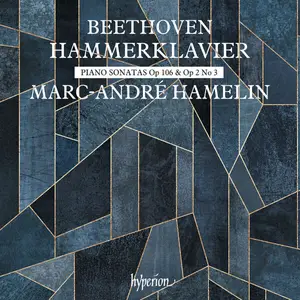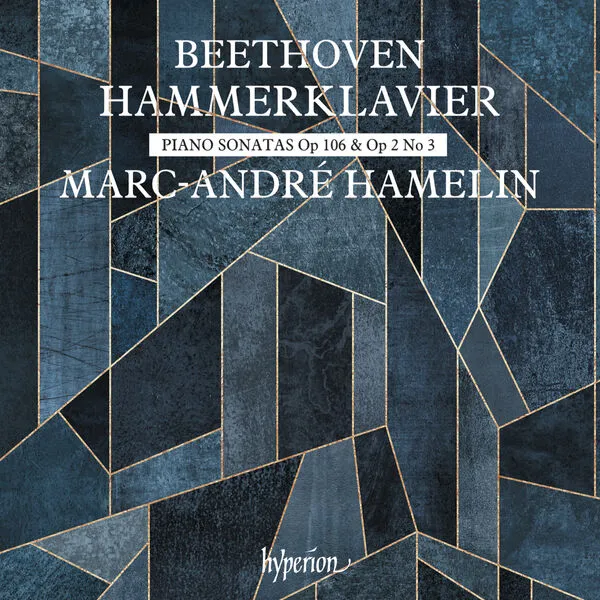Marc-André Hamelin - Beethoven: Piano Sonatas, Op. 2/3 & 106 (2024)
Cover +Digital Booklet | 01:08:59 | MP3 CBR 320 kbps | 162 MB
Classical | Label: Hyperion
Cover +Digital Booklet | 01:08:59 | MP3 CBR 320 kbps | 162 MB
Classical | Label: Hyperion
The ‘Hammerklavier’ sonata is by far Beethoven’s longest piano sonata, and in his view it was also his finest. It was begun in or just before December 1817, after a fallow period of over a year in which he had composed next to nothing, hindered by the after-effects of an infection in October the previous year, according to his own account. He seems to have intended from the outset to dedicate the sonata to Archduke Rudolph of Austria (1788-1831), who had been his pupil, friend, patron and chief supporter for nearly ten years. Its nickname derives from Beethoven’s search for a German word for the piano. The word used today, ‘Klavier’, could in those days mean either piano or harpsichord, and so after asking for advice he decided on ‘Hammerklavier’ for the instrument. He then used this term in his preceding sonata (Op 101 in A major), the present one, and the one after (Op 109 in E major). These other two sonatas, however, begin gently, whereas the hammer-like blows at the start of Op 106 suggest ‘Hammerklavier’ as an appropriate nickname. It was issued as a ‘grand sonata’, a term reserved by Beethoven for large-scale sonatas written and published separately.
Composition of the sonata took longer than usual, partly because of its great size and complexity, and partly because Beethoven was still not back to full health. As with all his major works, he made numerous sketches and rough drafts in the course of composing the sonata, but unfortunately a large number of them are lost, including a complete sketchbook (the so-called ‘Boldrini’ sketchbook) that was described by Gustav Nottebohm before disappearing around 1890. Beethoven claimed that the first two movements of the sonata had been completed in time for Rudolph’s name-day in 1818 (17 April), and the sketches seem to bear this out, although he made adjustments at a later date. The remaining two movements were completed later in 1818, but were evidently ready by about the end of the year.
While working on the sonata Beethoven received the gift of a Broadwood piano from London, bearing the signatures of some of that city’s leading musicians. It was sent in January 1818 and reached him in late spring. Most Viennese pianos at that time had a six-octave compass (FF to f''''), but the Broadwood had a lower six-octave compass (CC to c''''), and it is noticeable that the first two movements of the ‘Hammerklavier’ use the Viennese range but the last two use the Broadwood range. The net result is that the sonata as a whole uses every single note of the combined six-and-a-half octaves, a feature not found in any of his other sonatas. It also uses every key signature from six sharps to six flats, except one (four sharps). This was not done systematically, but simply arose as a result of the enormous tonal scope of the work.
Manuscript copies of the sonata were prepared around January 1819 and sent to two publishers—one in England (The Regent’s Harmonic Institution) and one in Vienna (Artaria & Co)—and both publishers issued it later that year with the dedication to Archduke Rudolph. Unfortunately, the ‘Hammerklavier’ is the only one of Beethoven’s late sonatas whose autograph score is lost, as are the two manuscript copies. The absence of these vital sources has led to considerable textual uncertainty in a few places, for neither printed edition is wholly reliable, even though Beethoven sent to England a correction list, most of which still survives. Most notorious are some natural signs that Beethoven forgot to add to all the As in bars 224-226 of the first movement (around 7'08 in this recording), leaving faulty A sharps that some pianists have observed too literally. Happily, this recording includes the notes Beethoven intended, rather than the faulty text that was printed in both original editions.
The ‘Hammerklavier’ is the only Beethoven sonata for which he supplied metronome marks. The metronome had been invented by Johann Nepomuk Maelzel around 1815, and Beethoven was the first major composer to make use of it to indicate precise speeds. He added metronome marks for all his symphonies, but he found the process tiresome and failed to produce them regularly for other works, even though he approved of the idea in principle. His metronome mark for the first movement of the ‘Hammerklavier’ is famous for being incredibly fast, and many musicians think it should be somewhat slower. This is how it is performed in this recording, to enable the intricate details to be better appreciated, although Beethoven’s pupil Carl Czerny said that the fast speed simply demands attentive practice.
Much of the sonata is based on rising and especially falling thirds. This is evident from the very first phrase, which begins with a rising third (albeit displaced by two octaves) and ends with a falling third. Beethoven uses these thirds at various levels—for example, the second main theme is in G major, a third lower than the B flat of the opening theme. The first movement is in sonata form, with a repeated exposition followed by development of some of the main ideas, then a recapitulation in which both main themes are now in the home key. A coda seems to be bringing the movement to a gentle, subdued ending, before two final loud chords emphasize the movement’s imposing character.
In most four-movement works the slow movement comes second, followed by a light-hearted minuet or scherzo; but where the first movement is particularly grand and majestic the scherzo works better if placed second, as here. As in the first movement, the opening phrase of the scherzo uses a rising third then a falling third. In most scherzos the first part consists of two repeated portions, but here the two repeats are an octave higher than the original version and slightly modified. The central part of the movement, sometimes known as the trio section, is in the minor, but again it begins with a rising then falling third. This section is then followed by a short presto section and a rapid ascending scale across the entire six-octave compass, before a slightly altered reprise of the opening section of the movement. The short coda veers abruptly into the improbable key of B minor, but returns equally abruptly to the home key.
The third movement is a passionate and highly expressive adagio in F sharp minor, a key Beethoven hardly ever used elsewhere, and its sad, somewhat tragic character is unmistakable, with long-drawn-out phrases and anguished dissonances. The opening melody begins with two successive falling thirds, intensifying the sense of dejection; however, after sending the work for publication, Beethoven astonishingly inserted a preliminary bar, consisting of a rising third, that cunningly links to the end of the previous movement while anticipating a similar motif later in the slow movement. This revision, which he sent to both publishers, is one of the most remarkable last-minute changes in the whole of music history. The movement as a whole is in sonata form, but with decorated recapitulation, and the extraordinarily low-pitched secondary theme is again placed in a key (D major) that is a third lower than the opening theme.
After such a profound movement, Beethoven produced an extended introduction to the finale—an introduction where time initially seems to stand still and there are not even any bar lines. A few fragmentary ideas follow, leading to an unaccompanied theme that heralds the start of a three-voice fugue of incredible complexity. The three-voice texture is maintained strictly until very near the end, but the part-writing is so dense that it often sounds like more than three voices. The main theme appears repeatedly, but sometimes upside down (inversion), back to front (retrograde) or at half speed (augmentation), requiring an astute listener to spot all the different versions. Suddenly the music stops and a new, gentler theme is developed, before being combined ingeniously with the original theme to add to the overall complexity. The fugue concludes with the initial three-note motif heard repeatedly in unison, each time one degree higher, leading to a final fortissimo cadence.
Beethoven’s first three piano sonatas were published when he was only twelve years old, but after moving to Vienna in 1792 he set about writing another set of three. Various other works intervened, however, and the set was not completed until 1795. It appeared the following year as his Op 2, published in Vienna by Artaria & Co and bearing a dedication to Haydn, who had earlier been Beethoven’s teacher for about a year. No autograph score survives, but the original edition was very carefully proof-read, passing through at least eight different states. Most of these reflect successive layers of correction, although some very minor errors were left to stand. The set was so successful that it was reprinted by several other publishers within the next ten years. All three sonatas contain four movements rather than the usual three, with an added minuet or scherzo as if looking towards the symphony genre, which Beethoven had not yet explored.
The third of the group is the longest and most powerful of the three, although it would scarcely stand comparison with the ‘Hammerklavier’. The first movement is in sonata form, but it owes something to the concerto genre, with an unusual cadenza-like passage near the end, before a final statement of the main theme. The second movement is in E major—this is the first of several C major works by Beethoven that use E as a subsidiary key (others include the ‘Waldstein’ sonata and Leonore Overtures Nos 2 and 3). Its opening theme, however, has a similar melodic outline to that of the first movement and is virtually a transformation of it. The central section of the movement is in E minor, but during the reprise in E major the main theme is suddenly hammered out in C major, as Beethoven cleverly draws attention to its connection to the first movement.
The scherzo is full of light-hearted humour, and the opening four-note figure is used almost obsessively during much of the main section. This figure actually has the same melodic outline as the first four notes of the previous movement (moving stepwise down–up–up), though in a different key and rhythm. A subsidiary ‘trio’ is in A minor, and the reprise of the scherzo is followed by a short coda. The finale is a blend of sonata-form and rondo elements, and its opening four notes (after the initial upbeat) create yet another version of the by-now-familiar stepwise pattern down–up–up. The movement’s unbounded energy is briefly interrupted by a more lyrical theme in F major, but the energy soon returns and builds up to multiple trills in the coda. These lead to a hesitant passage, as if taking a wrong turning, but the home key soon resumes in a final burst of enthusiasm.
TRACKLIST
01. Piano Sonata No. 29 in B-Flat Major, Op. 106 "Hammerklavier": I. Allegro
02. Piano Sonata No. 29 in B-Flat Major, Op. 106 "Hammerklavier": II. Scherzo. Assai vivace – Presto
03. Piano Sonata No. 29 in B-Flat Major, Op. 106 "Hammerklavier": III. Adagio sostenuto, appassionato e con molto sentimento
04. Piano Sonata No. 29 in B-Flat Major, Op. 106 "Hammerklavier": IV. Largo – Allegro – Allegro risoluto
05. Piano Sonata No. 3 in C Major, Op. 2 No. 3: I. Allegro con brio
06. Piano Sonata No. 3 in C Major, Op. 2 No. 3: II. Adagio
07. Piano Sonata No. 3 in C Major, Op. 2 No. 3: III. Scherzo. Allegro
08. Piano Sonata No. 3 in C Major, Op. 2 No. 3: IV. Allegro assai



